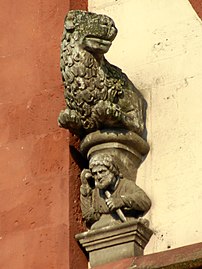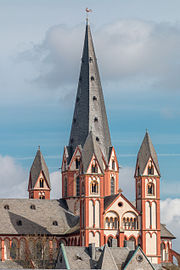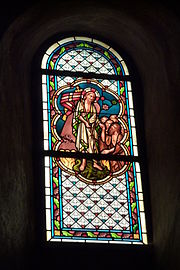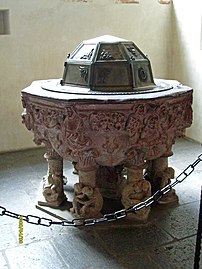Limburg Cathedral
| Limburg Cathedral | |
|---|---|
| St George's Cathedral, Limburg | |
Limburger Dom; Georgsdom | |
Diocese of Limburg |

Limburg Cathedral (German: Limburger Dom, also known as Georgsdom ("George's Cathedral") after its dedication to
The medieval patron saints of the church were
History
When the first church was built above the
Incidental archaeological discoveries from
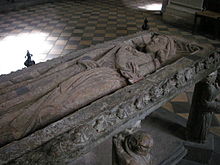
On 10 February 910, King
In the 11th century, that first church was replaced by an Early Romanesque basilica. A lead reliquary from the 11th century, found in 1776 in the main altar in the form of a schematic model of a church, mentions a Graf (count) Heinrich as founder and builder of a new "templum", that being apparently the new basilica.
In about 1180 an extensive remodelling was started that gave the church its present-day shape. In the western part, the nave and the transept, and the walls up to the top of the level of the galleries, are remainders of the Early Romanesque basilica. The Gothic modernization was begun in the west and proceeded eastward. Most of the windows and the western portal were enlarged in Gothic style, but the vaults of the aisles of the nave are still of Romanesque type. Relics of the Romanesque walls of the choir, including a bank of stone, can be seen below the arcades around the choir. The outer walls of the ambulatory are originally Gothic, and so are the vaults of the ambulatory. Many details inside the church suggest that the builders followed the example of Laon Cathedral, the construction of which had been started one or two decades before the Gothic reworking of the collegiate church in Limburg.
In 1802, during
The first bishop of Limburg was Jakob Brand (1827–1833). The diocese has currently about 700,000 Catholics and is one of the younger dioceses. On 2 February 2007, Pope Benedict XVI accepted the age-related resignation of former bishop Franz Kamphaus. Franz-Peter Tebartz-van Elst was named new bishop on 28 November 2007, and took office on 20 January 2008. He was suspended on 23 October 2013, he was thereupon general vicar Wolfgang Rösch, who in turn was replaced by Georg Bätzing, who was elected to the office of Bishop by the Cathedral Chapter, confirmed by Pope Francis and Ordained by Arch-Bishop Woelki in 2016, since 2020 he has been Chairman of the German Bishops‘ Conference.
Architecture
Exterior
The cathedral is a three-aisled
. The pointed crossing spire stands above all the other spires with a height of 66 m at the centre of the building. This height is the result of a lightning strike in 1774, before which the tower was 6.5 metres higher. The corner towers on the southern transept were erected in 1863.The west front is divided into five levels. The most eye-catching stylistic element is a huge round window, surrounded by eight small rosettes, which forms a clear centre of the west front. The rosette symbolises the
During restorations between 1872 and 1873, the polychrome exterior painting of the cathedral was removed (the colours were, previously, white, red, yellow-brown, black and a little green) and the stone was left bare. Between 1968 and 1972, the polychrome exterior was restored, using remains of the colour from the period before 1872 in order to reconstruct the old patterns.
-
Main portal with cloverleaf door opening and three-step pointed arch
-
The seated figure left of the main door is the patron Saint Nicholas
-
Rose window in the west front with early Gothic circular tracery
-
Bust of theEvangelist Markwith his symbol, the lion, on the west front
-
Saint George above the entrance to the cathedral, west front
-
The crossing spire and the towers of the transepts
-
Towers of the west front
Interior
The interior of the cathedral (nave and choir) is dominated by the completely undecorated buttresses, which reach all the way to the ceiling. More of the buttress system is hidden in the galleries of the side-aisles. The comparatively plain and bright interior is marked by a narrow, high central nave. It is divided into four levels with arcades, galleries, triforia and clerestories.
-
Interior from the narthex, looking east
-
Interior from the crossing, looking west
-
Crossing and transept, looking north
-
Medieval window in the back part of the cathedral (peristyle)
-
Late Romanesque frescoes above the galleries of the nave
-
Early modern frescoes above the nave arcade
-
Late Gothic wall painting of Saint Christopher
-
Late Gothic wall painting of the ancestry of Jesus
-
Late Romanesque baptismal font
-
The central nave towards the east


Organ


Organ playing is repeatedly documented in the 14th century; in 1443 two organs are mentioned.
Choirs
Choirs dedicated to singing services at the cathedral are the Limburger Domsingknaben, the Mädchenkantorei and the Domchor.
Bells
The cathedral's peal consists of nine
Two old bells hang in the north tower. The larger, called Sterm ("Stormbell") is a sugarloaf bell with neither symbol nor inscription, whose style dates it to 1200–1250. The smaller Uhrglocke ("hour bell") from the year 1447 originally hung in the uppermost window of the south tower. Since 1986 the two bells have been active once more. The Uhrglocke was made into a baptismal bell and is rung during every
| No. | Name | Casting year | Caster, Gussort |
Ø (mm) |
Weight (kg) |
Nominal (ST-1/16) |
Order of ringing (solistisch)[5] |
| 1 | Georg | 1906 | Petit & Gebr. Edelbrock, Location |
1910 | 4466 | a0 ±0 | Call to prayer / Transubstantiation on High Holidays, Death of the Pope, bishop or Cathedral cleric |
| 2 | Salvator | 1949 | 1600 | 2534 | c1 −2 | Hour of death of Jesus (3 pm), Call to prayer / Transubstantiation on ordinary Sundays | |
| 3 | Maria | 1410 | 1734 | d1 −1 | Angelus bell 6 pm, Call Lenten sermons | ||
| 4 | Josef | 1240 | 1137 | e1 −2 | Call to prayer for Feast of Joseph | ||
| 5 | Konrad Kurzbold | 1170 | 998 | f1 −2 | Angelus bell 7 am and noon | ||
| 6 | Nikolaus | 1030 | 648 | g1 −2 | Nicholas compline, Priest Thursday | ||
| 7 | Bernhard | 1906 | 910 | 468 | a1 +1 | – | |
| 8 | Sterm | 1200–1250 | unknown | 1031 | 570 | g1 +2/–2 | Work days of Holy Week |
| 9 | Uhrglocke | 1447 | 673 | ~260 | es2 −7 | Baptisms |
Concerts
The cathedral is used for concerts, such as the premiere of the oratorio Laudato si' on 6 November in 2016, composed by Peter Reulein on a libretto by Helmut Schlegel on a commission from the Diocese of Limburg.[7]
See also
- Saint George: Devotions, traditions and prayers
References
- ^ "Limburg Cathedral (Limburger Dom), Germany". www.sacred-destinations.com. Retrieved 12 June 2009.
- ISBN 3-7957-1370-6. Beiträge zur Mittelrheinischen Musikgeschichte 7,2.
- ^ Limburger Domsingknaben, Jahresbericht 2012, p. 61 (PDF-Datei; 3,53 MB), retrieved on 16 November 2014.
- ^ Disposition der Klais-Orgel, accessed on 16 November 2014.
- ^ a b c Läuteordnung des Limburger Domes Archived 19 March 2013 at the Wayback Machine
- ^ Hubert Foersch: Limburger Glockenbuch – Glocken und Geläute im Bistum Limburg. Verlag des Bischöflichen Ordinariates, Limburg 1997, pp. 557–562.
- Diocese of Limburg: 5–6. Retrieved 9 January 2017.
Bibliography
- Matthias Theodor Kloft: Dom und Domschatz in Limburg an der Lahn. Verlag Langewiesche, Königstein im Taunus 2016 (= Die Blauen Bücher) ISBN 9783784548265
- Matthias Theodor Kloft: Limburg an der Lahn – Der Dom. Verlag Schnell und Steiner, 19th revised edition, 2015, ISBN 9783795443658
- Pfarrgemeinderat der Dompfarrei Limburg (ed.): 750 Jahre Limburger Dom – 1235–1985. Limburg 1985
- Georg Ulrich Großmann: Mittel- und Südhessen: Lahntal, Taunus, Rheingau, Wetterau, Frankfurt und Maintal, Kinzig, Vogelsberg, Rhön, Bergstraße und Odenwald. DuMont, Köln 1995 ISBN 3770129571(= DuMont Kunst-Reiseführer), pp. 66–69
- Robert Laut: Die Herrschaft Limburg und ihr Übergang von den Konradinern über die Häuser Gleiberg-Luxemburg, Peilstein, Leiningen an Isenburg. In: Nassauische Annalen, 65. Band, 1954. pp. 81–85
- Walter Lutz: Zur Geschichte der Kirchenmusik am Dom zu Limburg von den Anfängen bis zur Gegenwart. Schott, Mainz 1986 ISBN 3795713285(Beiträge zur mittelrheinischen Musikgeschichte 27)
- Wolfgang Metternich: Der Dom zu Limburg an der Lahn. Wissenschaftliche Buchgesellschaft, Darmstadt 1994 ISBN 3534015797
- Wolfgang Metternich: Die Entstehung der Stifts- und Domkirche in Limburg an der Lahn. In: Nassauische Annalen, 104. Band, 1993. pp. 1–28
- Wolfram Nicol (ed.): Der Dom zu Limburg. Gesellschaft für Mittelrheinische Kirchengeschichte, Mainz 1985 (Digitalisat)
- Wolf-Heino Struck: Die Gründung des Stifts St. Georg und die Erbauung der heutigen Kathedrale in Limburg a.d. Lahn. In: Nassauische Annalen, 97. Band, 1986. pp. 1–31
- Rudolf Wolf: Die Säkularisation des St. Georg-Stifts zu Limburg im Jahre 1803. In: Archiv für mittelrheinische Kirchengeschichte 55 (2003), pp. 333–379
- Rainer-Josef Zensen: Der Dom St. Georg zu Limburg an der Lahn. In: Nassauische Annalen. Band 110, 1999 ISSN 0077-2887, pp. 57–70
External links
- History and facts about Limburg Cathedral
- The Ecclesiologist, by Cambridge Camden Society, Ecclesiological Society
- Remarks on church architecture, by John Louis Petit




